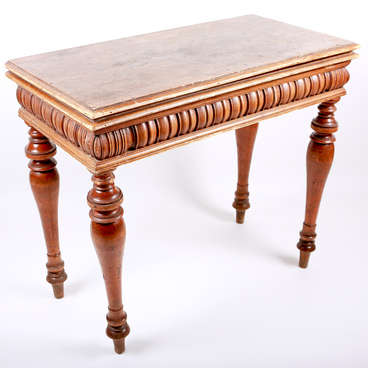The collection of the Kasimov Museum-Reserve contains a samovar-kitchen, used not only to brew tea, but also to cook food. The pot was made in the 19th century at the factory of Nazar Lisitsyn in Tula.
In 18th — 19th centuries, the samovar was an important item in every home: tea was often used to start the morning; merchants concluded deals and received guests over tea. A samovar-kitchen was also used in roadside taverns, tea houses, hotels, inns and fairs. Travelers took such a pot with them for long journeys: it replaced a field kitchen.
The samovar-kitchen differed from other similar items by its shape: it was similar to a deep pot, which was divided by partitions into two or three equal parts inside. So, in one part you could cook some hot meal, and in the other part — make some tea.
Each part of the samovar-kitchen had a separate lid, and the compartment for tea had a tap used to pour a drink. On the sides of the pot, there were two wide handles, which allowed moving the samovar quickly and easily. In the lower part, there was a base plate and sometimes coals were put there to keep the temperature of the pot.
Tula factory, where the samovar-kitchens were produced, was founded by the Lisitsyn merchants. The father of the family, Fyodor Lisitsyn, worked in the production of copper and brassware, and his sons Ivan and Nazar helped to process the metals since childhood. In 1778, the merchants produced the first samovar, and at the same time Nazar Lisitsyn registered the first samovar factory in Tula — it was located on Shtykovaya Street.
As time passed, the volume of production grew. By 1830, Lisitsyn’s factory began to produce more than 600 samovars per year. The samovars were a great success at the Nizhny Novgorod fair, where the producers had a stall in the Gostiny Dvor.
Lisitsyn samovars were also popular abroad, for example in the cities of Khiva and Bukhara in Central Asia. There, Tula merchants traded in “Persian” products — they were made in the form of a sphere specifically for the East. Now the Bukhara Museum Reserve in Uzbekistan houses a samovar with the label “Ivan Lisitsyn in Tula. 1810.”
In 18th — 19th centuries, the samovar was an important item in every home: tea was often used to start the morning; merchants concluded deals and received guests over tea. A samovar-kitchen was also used in roadside taverns, tea houses, hotels, inns and fairs. Travelers took such a pot with them for long journeys: it replaced a field kitchen.
The samovar-kitchen differed from other similar items by its shape: it was similar to a deep pot, which was divided by partitions into two or three equal parts inside. So, in one part you could cook some hot meal, and in the other part — make some tea.
Each part of the samovar-kitchen had a separate lid, and the compartment for tea had a tap used to pour a drink. On the sides of the pot, there were two wide handles, which allowed moving the samovar quickly and easily. In the lower part, there was a base plate and sometimes coals were put there to keep the temperature of the pot.
Tula factory, where the samovar-kitchens were produced, was founded by the Lisitsyn merchants. The father of the family, Fyodor Lisitsyn, worked in the production of copper and brassware, and his sons Ivan and Nazar helped to process the metals since childhood. In 1778, the merchants produced the first samovar, and at the same time Nazar Lisitsyn registered the first samovar factory in Tula — it was located on Shtykovaya Street.
As time passed, the volume of production grew. By 1830, Lisitsyn’s factory began to produce more than 600 samovars per year. The samovars were a great success at the Nizhny Novgorod fair, where the producers had a stall in the Gostiny Dvor.
Lisitsyn samovars were also popular abroad, for example in the cities of Khiva and Bukhara in Central Asia. There, Tula merchants traded in “Persian” products — they were made in the form of a sphere specifically for the East. Now the Bukhara Museum Reserve in Uzbekistan houses a samovar with the label “Ivan Lisitsyn in Tula. 1810.”


